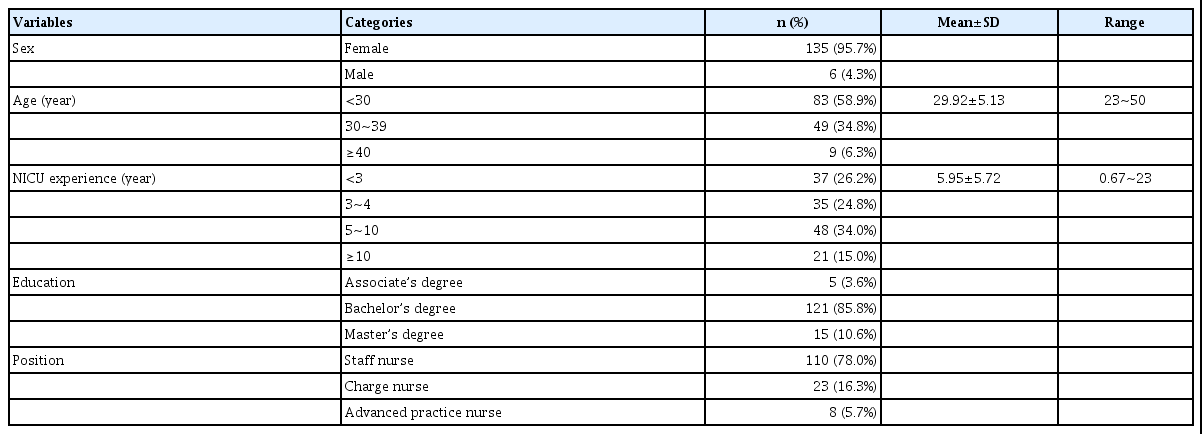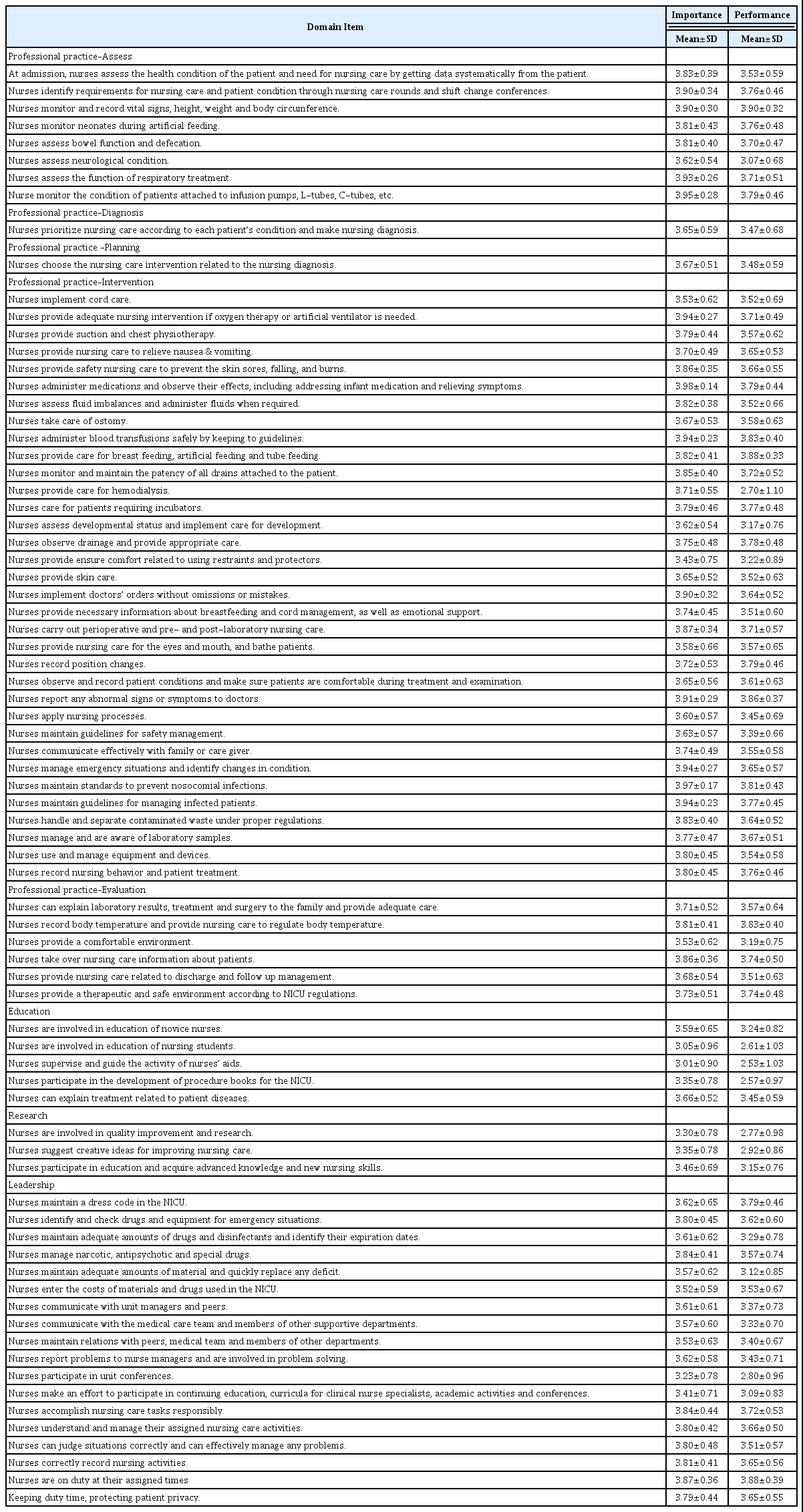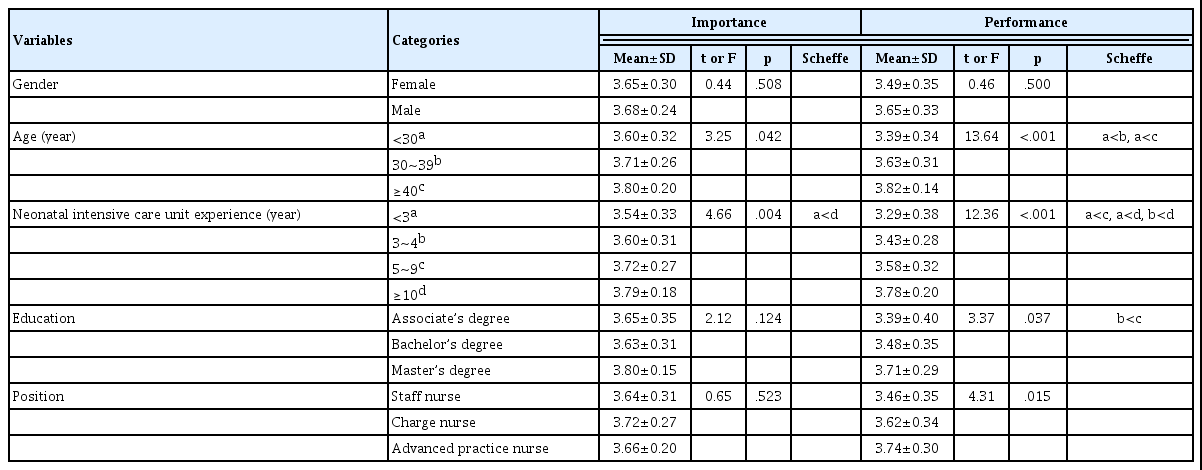신생아중환자실 간호사가 인식한 간호업무의 중요도와 수행 자신감
Analysis of the importance of nursing care and performance confidence perceived by nurses in the neonatal intensive care unit
Article information
Abstract
Purpose
Neonatal nurses are expected to have clinical competency to provide qualified and safe care for high-risk infants. An educational intervention to enhance nurses’ clinical competence is often a priority in the nursing field. This study was conducted to explore nurses’ perceived importance and performance confidence of nursing care activities in neonatal intensive care units.
Methods
One hundred forty-one neonatal nurses from seven hospitals across South Korea participated in the online survey study. The scale of neonatal nursing care activity consisted of 8 subdomains including professional practice (assessment, diagnosis, planning, intervention, evaluation, education, research, and leadership). The Importance-Performance Matrix was used to analyze the importance of and confident performance in each of the nursing subdomains.
Results
Both importance and performance confidence increased as nurses’ age (p=.042 and p<.001) and clinical experience (p=.004 and p<.001). Participants scored relatively higher in importance and performance confidence in the professional practice subdomains (assessment, intervention, evaluation), but scored lower in the education and research subdomains.
Conclusion
To provide evidence-based nursing care for high-risk infants in neonatal intensive care units, educational interventions should be developed to support nurses based on the findings of the research.
서 론
연구의 필요성
2019년 국내 가임 여성 1인당 출산율은 0.92명으로 OECD (Organization for Economic Cooperation and Development, OECD) 국가의 평균인 1.63명에 비해 매우 낮은 수준이다. 그러나 국내 임부의 고령화와 생식보조술의 사용 증가는 미숙아를 포함한 고위험 신생아의 출산율을 계속해서 증가시키고 있으며, 미숙아(임신기간 37주 미만)의 출생률은 8.1%로 10년 전의 5.7%에 비해 크게 증가하였다[1]. 신생아중환자실(Neonatal Intensive Care Unit, NICU)의 의료기술과 장비의 발달은 고위험 신생아의 생존율을 크게 향상시켰고, 이에 따라 신생아중환자실 환아에게 집중적이고 전문적인 간호를 제공할 수 있는 임상역량이 간호사에게 더욱 요구되고 있다.
신생아중환자실 간호사는 성인이나 소아중환자실에서 제공하는 집중간호 이외에 분만 합병증, 선천적 심장 기형과 같은 선천적 문제의 교정, 외과적 질환 그리고 미성숙한 신체 기능으로 인해 발생하는 다양한 건강문제에 대해 치료와 간호를 제공하게 된다[2].
의료환경에 따라 요구되는 간호사의 업무를 수행하기 위해서는 충분한 역량이 습득되어야 한다. 국내의 많은 의료기관은 신입간호사에게 임상현장에서 필요한 실무능력을 습득할 수 있도록 추가적인 교육을 제공하고 있다[3]. Kirrane [4]은 신생아중환자실에 입원한 신생아에게 필요한 간호요구를 3가지 범주로 분류하면서, 호흡양상 사정과 심박수 청진을 포함한 간호는 경증의 질환을 갖은 신생아에게, 정맥 영양이나 양압환기의 간호는 중증도의 신생아에게, 그리고 인공호흡기, 순환보조 등의 간호는 심각한 중증 질환을 가진 신생아에게 제공한다고 하였다. 신생아중환자실에서 근무하는 간호사는 환자 가족이 신생아와의 애착을 형성하고 치료에 참여하도록 도우며, 치료가 어려운 신생아에 대한 정서적 지지나 완화치료 등을 제공해야 한다[5]. 질환으로 인해 입원한 신생아는 치료가 종료되면 집으로 퇴원하는 이행과정을 겪게 되는데, 신생아중환자실 간호사는 이 이행과정에서 부모가 자녀의 돌봄과 간호를 안전하게 수행할 수 있도록 교육도 제공해야 한다[6]. 신생아 중환자의 간호 요구도를 측정하기 위해 개발된 한국형 신생아중환자간호 분류도구는 신생아 중환자의 간호 업무를 11개의 영역으로 분류하였다[7]. 각 영역은 활력징후 측정 및 감시, 신체사정 및 검사, 호흡간호, 기동성, 위생간호 및 감염관리, 영양, 배설, 투약 및 수혈, 처치 및 시술, 정서적 지지 및 상담과 교육, 입원과 퇴실관리로 구성되어 있으며, 신생아의 위생과 영양이라는 일반적인 아기돌봄부터 호흡간호와 수혈과 같은 중환자 간호, 그리고 교육과 정서적 지지를 포함한 다양한 간호업무를 제시하였다[7]. 신생아중환자실에서 제공되는 간호는 신생아와 중환자실이라는 특수성으로 인해 매우 다양하며 복잡하다고 할 수 있다.
IPA (Importance-Performance Analysis)는 간호학에서 많이 사용하는 분석 방법으로[8-13]. 분석하고자 하는 내용(항목)의 중요도와 수행도를 각각 X축과 Y축의 4사분면에 표시하여 각 항목에 대해 투입되는 노력과 중요도를 비교함으로써 제한된 물적, 인적 자원을 효율적으로 배분하는데 도움이 된다. IPA는 중요도와 수행도를 시각화하여 추가적인 교육이 필요한 항목과 교육의 우선순위를 파악하여 효과적인 교육이 제공되도록 한다[14].
그동안 병동(임상 부서), 간호사의 일반적 특성에 맞는 교육을 제공하기 위해 선행된 연구[13,15,16]가 있으며 국내외 신생아중환자실 간호 업무와 역량에 대한 연구[2,5,17,18]가 진행되었다. 그러나 국내 신생아중환자실 간호사를 대상으로 진행된 선행연구는 신생아중환자실의 가족중심간호, 생애 말기 신생아의 완화의료와 같은 특수한 상황에서 필요한 간호사의 역량을 연구하여, 신생아중환자실 간호사가 갖춰야 할 일반적인 임상 역량이나 업무에 대해 전반적으로 다루지 못한 제한점이 있었다. 또한 국내 간호사를 대상으로 한 연구는 대부분 단일기관연구로 대표성이 부족하다고 할 수 있다. 이에 본 연구에서는 국내 신생아중환자실 간호사가 인식하는 신생아중환자실 간호 업무에 대한 중요도와 수행 자신감을 조사하여 IPA 방법으로 분석하여 신생아중환자실 간호사에게 우선적으로 제공되어야 하는 교육 영역을 확인하고자 하였다.
연구 목적
본 연구의 목적은 신생아중환자실 간호사가 인식한 간호 업무에 대한 중요도와 수행 자신감을 조사하여 비교 분석하기 위한 연구이다. 구체적인 목표는 다음과 같다.
• 신생아중환자실 간호사의 간호 업무의 중요도와 수행 자신감을 확인한다.
• 신생아중환자실 간호사의 일반적 특성에 따른 간호 업무의 중요도와 수행 자신감의 차이를 확인한다.
• IPA 방법을 이용하여 신생아중환자실 간호 업무의 중요도와 수행 자신감을 비교 분석한다.
연구 방법
연구 설계
본 연구는 신생아중환자실 간호사가 인지한 간호 업무의 중요도와 수행 자신감을 조사하기 위한 횡단적 설문조사연구이다.
연구 대상
본 연구는 서울 소재 상급종합병원 6개와 제주도 소재 종합병원 1개를 포함한 총 7개 병원의 간호사를 대상으로 하였다. 선정기준은 신생아중환자실에서 6개월 이상 근무한 경력이었으며, 자발적으로 연구에 참여한 간호사는 145명이었다. 145명의 설문 중 설문 응답이 불완전한 4명의 설문을 제외하여 총 141개의 설문 자료를 분석하였다. G-power 프로그램을 사용하여 검정력 .8, 효과크기 .3, 유의수준 .05으로 ANOVA 분석에 필요한 표본 크기를 구한 결과 128명으로 본 연구의 대상자 수는 통계분석하기에 충분하였다.
연구 도구
● 신생아중환자실 간호사의 간호 업무 중요도 및 수행 자신감
Park과 Lee [17]는 신생아중환자실 간호사의 업무 표준을 확인하여 간호사 업무를 평가하고 간호 업무의 수준 향상을 위해 신생아중환자실 간호업무 도구를 개발하였다. 이 도구는 간호사의 지식, 기능, 태도, 직무수행과정, 직무성과 등을 복합적으로 평가하는 총 76개 항목으로 구성되어 있다. 신생아중환자실 간호사의 업무는 전문적 간호(49개 항목)에 해당하는 ‘간호 사정’, ‘진단’, ‘계획’, ‘수행’, ‘평가’의 5개 하위영역과 ‘교육(5개 항목)’, ‘연구(3개 항목)’, ‘리더십(19개 항목)’의 3개 하위영역을 포함하여 총 8개 하위영역으로 구성되어 있다. 도구 개발 당시 심도 있는 문헌고찰 결과를 토대로 예비 문항을 개발하였고, 경력 10년 이상인 전문가 15명을 대상으로 타당도를 확인하였으며, overall CVI (content validity index) 계수는 .75이었다. 또한 신생아중환자실 간호사 45명을 대상으로 도구의 신뢰도를 확인한 결과 Cronbach’s alpha는 .99이었다. 본 연구에서 도구의 신뢰도 Cronbach’s alpha는 .97이었다.
본 연구에서 연구대상자는 위의 76개 항목에 대해 “신생아중환자실 간호 업무 중 다음 항목은 얼마나 중요하다고 생각하십니까?”와 “신생아중환자실 간호업무 중 다음 항목을 수행하는데 얼마나 자신이 있으십니까?”에 대해 4점 척도(1점: 전혀 중요하지 않다, 4점: 매우 중요하다)로 응답하게 하였다. 또한 대상자의 일반적 특성으로는 성별, 연령, 최종학력, 신생아중환자실 근무 기간, 병동 내 직위(역할)을 조사하였다.
자료 수집 방법
IRB (Institutional Review Board, IRB) 승인 후 자료수집을 시작하였으며, 2019년 1월부터 8월까지 진행하였다. 자료수집을 위해 한국 신생아간호사회의 회장에게 연구의 목적과 의의 그리고 진행 방법에 대해 설명하고 협조를 얻은 후 진행하였다. 회장을 통해 본 연구에 관심이 있는 신생아중환자실 수간호사(관리자, 파트장)에게 연구에 대해 설명하고 온라인 설문에 접속할 수 있는 링크를 이메일로 전달하였다. 각 병원 신생아중환자실에 근무하는 간호사는 이메일을 통해 전달받은 온라인 링크를 통해 설문지에 응답하였으며 설문 응답에 소요되는 시간은 약 15분 정도이었다. 연구 참가자에게 소정의 모바일 쿠폰(사례비)을 제공하였다.
자료 분석 방법
연구에서 수집된 자료는 IBM SPSS/WIN 25.0 프로그램을 활용하여 분석하였다. 대상자의 일반적 특성과 간호 업무의 중요도와 수행 자신감은 기술 통계를 이용하여 분석하였고, 대상자의 일반적 특성에 대한 간호 업무의 중요도와 수행 자신감의 차이를 확인하기 위해 t-test와 one-way ANOVA를 이용하였다. 필요 시 Scheffe test로 사후 검정을 실시하였다. 신생아중환자실 간호 업무의 중요도와 수행 자신감은 추가적으로 Importance-Performance Matrix를 작성하였다. IPA 결과 1사분면은 중요도와 수행 자신감이 모두 높은 영역으로 계속 유지하는 것이 필요하고, 2사분면은 높은 중요도에 비해 수행 자신감이 낮은 영역으로 우선적으로 집중 교육이 필요하다고 해석될 수 있다. 3사분면 중요도와 수행 자신감 모두 낮은 영역으로 교육의 순위가 낮은 영역이고, 4사분면은 낮은 중요도에 반해 높은 수행 자신감을 보이는 영역으로 과잉 투자나 교육이 이루어진 영역으로 해석될 수 있다[19].
연구의 윤리적 고려
연구는 Y대학교의 생명윤리심의위원회 승인을 받은 후(IRB No. Y-2019-0072) 시행하였다. 연구에 참여하기를 원하는 대상자는 전달된 링크를 클릭하여 연구에 참여를 결정할 수 있었으며, 설문 응답 전에 연구의 목적과 방법 등이 포함된 설명문을 확인하도록 하였고 설명문에 연구 참여 도중 원하면 언제든지 연구 동의 철회가 가능하고 철회 시 어떠한 불이익도 받지 않을 것임에 대해 표기되었다. 연구 기간 동안 수집된 자료는 연구 목적으로만 사용하고, 연구자만 알 수 있도록 처리한 후 잠금 장치가 있는 보관 장소에 보관할 것임을 포함하였다.
연구 결과
연구대상자의 일반적 특성
대상자의 대부분(95.7%)은 여성이었으며, 연령의 범위는 23세부터 50세이고 평균 연령은 29.92±5.13세이었다. 신생아중환자실 근무 경력은 8개월부터 23년이고, 평균은 5.95±5.72년이었다. 대부분(85.8%)의 대상자는 학사학위자이었으며, 석사학위자는 15명(10.6%)이었다. 현재 직위는 대부분(78.0%)이 일반 간호사였으며, 상급전문간호사는 8명(5.7%)이었다(Table 1).
신생아중환자실 간호 업무의 중요도와 수행 자신감
간호 업무의 중요도와 수행 자신감은 Table 2와 같다. 간호 업무의 중요도 평균은 3.70±0.30이었으며, 가장 점수가 높은 영역은 전문적 간호–사정(3.84±0.23)이었고 가장 낮은 영역은 교육 (3.33±0.61)이었다. 사정 영역의 세부 업무 중 ‘환자에 연결되어있는 tube, infusion pump 등에 대한 사정’(3.95±0.23)이 가장 높았고, ‘신경학적 사정’(3.62±0.54)은 가장 낮았다(Table 2). 교육 영역에 해당하는 업무 중 ‘환자의 질환과 관련하여 치료에 대해 설명’ 항목이 3.66±0.52로 가장 높았고, ‘간호보조인력의 감시와 지시’가 3.01±0.90으로 가장 낮았다.
반면에 수행 자신감에서는 전체 평균이 3.50±0.35로 중요도와 마찬가지로 전문적 간호–사정(3.65±0.34)이 가장 높았고, 교육(2.88±0.67)이 가장 낮았다. 전문직 간호–사정 영역 중 ‘신체 계측과 활력징후의 감시 및 기록’(3.90±0.32)이 가장 높은 수행 자신감을 나타냈으며, ‘신경학적 사정’(3.07±0.68)이 가장 낮은 점수를 나타냈다. 간호업무의 수행 자신감은 ‘환자의 질환과 관련하여 치료에 대해 설명’(3.45±0.59)이 가장 높았고 ‘간호보조인력의 감시와 지시’(2.53±1.03)는 가장 낮았다(Table 2).
● 대상자의 일반적 특성에 따른 중요도와 수행 자신감의 비교
대상자의 일반적 특성에 따른 간호업무의 중요도와 수행 자신감의 차이는 Table 3과 같다. 대상자의 연령과 신생아중환자실 근무 경력에 따라 간호업무 중요도(p=.004)와 수행 자신감(p<.001)이 유의미한 차이가 있었다(Table 3). 연령과 경력이 많을수록 간호 업무의 중요도와 수행 자신감의 점수가 높았다. 간호업무 수행 자신감은 대상자의 학력(p=.037)과 직위(p=.015)에 따라 유의한 차이가 있었으며, 학력이 높을수록 수행 자신감 점수가 높았고, 상급전문간호사의 경우 수행 자신감 점수가 높았다(Table 3).
● 신생아중환자실 간호 업무의 중요도와 수행 자신감 비교 분석
신생아중환자실 간호업무의 8개 하위 영역의 중요도와 수행 자신감을 IPA matrix를 이용하여 제시하였다(Figure 1). 중요도와 수행 자신감이 모두 높은 1사분면에는 전문적 간호–사정, 중재, 평가의 영역이 포함되었다. 중요도와 수행 자신감이 모두 낮은 3사분면에는 전문적 간호–진단과 계획, 교육, 연구, 리더십의 총 5개 영역이 포함되어 있었다. 이 중 진단과 계획, 리더십은 전체 평균에 가까운 위치에 있는 반면에 교육과 연구는 매우 낮은 중요도와 수행 자신감을 나타냈다. 중요도는 높으나 수행 자신감이 낮은 2사분면과 중요도는 낮으나 수행 자신감이 높은 영역인 4사분면에 해당하는 간호업무 영역은 없었다(Figure 1).
논 의
본 연구는 신생아중환자실 간호사가 인식하는 간호 업무의 중요도와 수행 자신감을 IPA 방법으로 분석하여 신생아중환자실 간호업무 역량을 향상시키기 위한 기초 자료로 사용하기 위해 시도되었다.
국내 7개 병원의 신생아중환자실 간호사 141명이 온라인 설문에 응답하였으며, 신생아중환자실 간호 업무 중 전문적 간호에 해당하는 ‘사정(assessment)’, ‘중재(intervention)’, ‘평가(evaluation)’
영역이 모두 IPA matrix의 1사분면에 위치하여 중요도와 수행 자신감 모두 높은 것으로 나타났다. ‘사정’ 영역은 신생아중환자실에 입원한 고위험 신생아의 상태를 사정하는 항목이 포함되어 있으며, 세부항목 중 ‘환자에 연결되어있는 tube, infusion pump 등에 대한 사정’, ‘신체 계측과 활력징후의 감시 및 기록’, ‘rounding을 통한 환자 사정’의 순서로 점수가 높았다. 요양병원 간호사의 업무에 대한 연구[20]에서도 ‘환자 상태 사정’, ‘응급상황관리’, ‘간호 전×중×후 사정’을 포함한 잠재적 위험관리 영역에서 중요도와 수행도가 높게 보고되었으며, Kim 등[8]의 연구에서도 중환자실 간호 실무 중 신체사정이 수행도에서 가장 점수가 높았고 중요도에서는 두번째로 높은 항목이었다. 호남지역 6개의 신생아중환자실을 대상으로 한 선행연구[21]에서도 사정을 포함한 전문적 간호 행위 영역이 다른 영역에 비해 높은 수행도를 보여 본 연구와 비슷한 결과가 보고되었다. 전문적 간호 역량 중 중재에 포함되어 있는 항목인 ‘약물의 투여와 약물에 대한 효과와 증상의 관찰’ 항목이 가장 높은 중요도 점수를 나타냈고, ‘인공수유, 모유수유, 튜브수유를 통한 영양공급의 제공’ 항목이 가장 높은 수행 자신감 점수를 보였다. Song과 Moon [11]의 연구에서도 35개의 간호 역량 중 투약과 관련된 업무가 수행도와 중요도 모두에서 가장 높은 점수를 보여 비슷한 연구결과를 보고하였다. 신생아중환자실 간호사의 업무를 분석한 Ahn과 An [22]의 연구에서 신생아 수유와 관련된 영양간호가 간호사 업무 중 가장 많은 시간과 빈도를 차지한다고 보고하였는데, 간호사의 높은 수행 자신감을 보인 결과를 뒷받침한다고 할 수 있다. 전문적 간호업무 영역 중 평가영역에서 ‘환자에 대한 정보 인수인계’ 항목이 중요도에서 가장 높았으며, Park 등[9]의 응급실 간호사의 34개의 업무를 분석한 연구에서 ‘환자에 대한 정보를 공유함’ 항목이 가장 높은 중요도를 나타나 간호사로서 환자의 정보에 대한 공유는 모든 부서에서 중요하다고 인식하고 있는 것을 알 수 있다. 또한 ‘환자의 체온 평가와 체온 조절을 위한 간호 제공’이 가장 높은 수행 자신감을 보였는데, 체온 측정은 환자의 상태를 확인하기 위해 빈번하게 수행하는 간호활동으로 수행 자신감이 높게 나타난 것으로 생각된다. 신생아중환자실 간호업무 중 ‘측정 및 감시 간호’는 영양간호 다음으로 가장 많은 간호 활동 시간에 해당한다[22].
본 연구에서 교육과 연구 영역은 중요도와 수행 자신감 모두에서 낮은 점수를 보여 4사분면에 위치하였다. 교육의 세부항목 중 ‘환자의 질환과 관련된 치료에 대한 설명’이 가장 높은 중요도와 수행 자신감 점수를 보였고, 그 다음은 ‘신규간호사 교육에 참여’, ‘간호학생 교육에 참여’, ‘간호보조인력의 감시와 지시’ 항목 순이었다. 이 결과는 전라북도 소재 요양병원 간호사[20], 외국 간호사[23], 수도권 소재 3개의 대학병원 간호사[24]에게 시행한 선행연구에서 교육 영역이 다른 간호 영역에 비해 상대적으로 낮은 수행도와 중요도를 보인 것과 비슷하다. 신생아중환자실 간호요구도를 측정한 연구[22]에서 교육은 다른 업무와 마찬가지로 신생아중환자실 간호사에게 필요한 능력이라고 하였으며, Shin 등[25]의 연구에서도 간호사의 임상간호교육자의 역할, 간호교수학습이론과 같은 간호교육에 대한 요구는 높았으나 대부분의 보수교육이 간호 실무로 구성되어 있어 교육자로서의 역량을 갖추기에 어려움이 있다고 하였다. 그러나 신생아중환자실은 질병이 있는 환아와 가족이 치료와 간호에 참여[6,18]하기도 하고, 복잡한 역할들을 요구하기 때문에 환아 가족에 대한 교육적 능력이 요구되어, 신생아중환자실 간호사를 대상으로 교육에 대한 인식, 영향 요인, 교육 프로그램의 개발 등에 대한 추가적인 연구가 필요하다고 볼 수 있다.
3사분면에 위치한 연구 영역의 세부항목은 ‘병동 내 질 향상 활동에 참여’, ‘간호를 향상시키기 위한 창의적 아이디어 제안’, ‘새로운 간호기술과 지식을 위한 교육에 참여’ 순서로 중요도와 수행 자신감의 점수가 높았다. Meretoja 등[26]의 연구에서도 ‘향상된 업무나 연구를 위한 제안’, ‘환자간호를 위한 간호 연구 등의 활용’ 항목이 낮은 점수를 보인 것과 비슷한 결과였다. 임상 간호사에게 연구는 근거중심간호를 뒷받침하는 중요한 요인이며 이에 대한 의료기관과 관리자의 인식이 중요한 요인으로 보고되고 있다[27,28]. 국내의 경우 임상실무에서 연구의 필요성은 인지되고 있으나[29], 간호사의 능동적 연구 활동 수준과 연구를 통한 근거기반 실무에 대한 인식이나 수행률은 모두 낮다고 하였다[28]. 또한 환자 치료의 과정에서 최신의 연구결과가 아닌 기존의 지식이나 이전 환자간호 경험 등에 의존하는 경우가 많다고 하였다. 임상실무에서 연구의 인식, 필요성, 연구결과 활용을 위한 방안 등에 대한 체계적인 연구가 필요하다고 생각된다.
신생아중환자실 간호사의 일반적 특성 중 중요도와 수행 자신감 모두에 영향을 미치는 요인으로는 신생아중환자실 경력으로, 경력이 증가할수록 간호 업무의 중요도와 수행 자신감이 증가하였다. 간호역량에 대한 선행연구[16,21,24,26]에서 근무 경력이 증가함에 따라 업무에 대한 역량이 상승한다는 결과와 비슷하다고 할 수 있으며 신생아중환자실 간호사를 대상으로 업무 수행도를 확인한 연구[21]에서도 1~2년의 근무 경력 간호사보다 10년 이상의 간호사가 업무에 대한 수행 정도가 높다는 결과와 유사하였다. 간호는 업무특성 상 동일한 부서에 대한 근무 기간이 증가함에 따라 업무에 대한 자신감과 책임감을 포함한 전문성 향상과 업무역량이 증가하는 것으로 생각되며[24], 간호사에 대한 교육과 간호지식은 시대에 따라 변화할 수 있지만 임상 경험을 통해 체득한 간호 업무는 여전히 수행 자신감에 중요한 역할을 하는 것으로 생각된다[29]. 이에 교육을 제공하기 전에 임상실무에서 요구되는 간호업무 역량에 대한 기초 조사와 이를 향상시키기 위한 연구와 교육이 필요하다고 할 수 있다.
본 연구는 다음의 제한점이 있다. 국내 7개 병원을 대상으로 간호사를 모집하였으나 대부분 서울 소재 상급종합병원의 간호사로 국내 신생아중환자실 간호사를 대표하기에는 어려움이 있다. 또한 연구에서 사용한 간호사의 업무 수행평가 도구는 2011년에 개발되어 최근의 신생아중환자실에서 제공하고 있는 모유수유교육, 캥거루 간호, 체외순환장치, 초극소 저체중아 관리 등에 대한 내용이 포함되어 있지 않은 점을 유의하여 해석해야 한다.
결론 및 제언
본 연구는 국내 7개 상급/종합병원의 신생아중환자실 간호사를 대상으로 76문항의 신생아중환자실 간호 업무에 대한 중요도와 수행 자신감을 조사하여 IPA matrix 분석을 시도하였다. 본 연구 결과 간호사의 연령과 근무 기간이 길수록 간호 업무의 중요도와 수행 자신감이 높았으며, 신생아중환자실 환아의 전반적인 상태를 확인하는 간호 사정, 처방된 처치를 수행하는 간호 중재 그리고 수행한 간호에 대해 평가하는 3가지 업무영역은 중요도와 수행 자신감 모두에서 높은 점수를 나타냈다. 반면에 간호업무 중 교육과 연구는 상대적으로 덜 중요하게 인식하고 수행 자신감도 낮았다. 신생아중환자실 간호사는 가족중심간호와 근거기반간호를 제공하기 위해 교육과 연구 영역에서 중요도 인식을 향상시키고, 관련 교육 프로그램을 제고하여 수행 자신감을 향상시키는 것이 필요할 것이다. 본 연구의 결과는 신생아중환자실 간호사들을 위한 간호업무 역량 향상 교육 프로그램 개발의 근거로 활용될 수 있으며 향후 근무 병원의 규모별, 경력별, 영역별로 세분화하여 반복 연구가 필요할 것이다.
Notes
No potential conflict of interest relevant to this article was reported.
Funding
None
Acknowledgements
None
Supplementary materials
None




